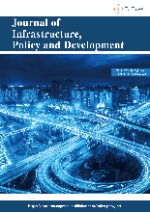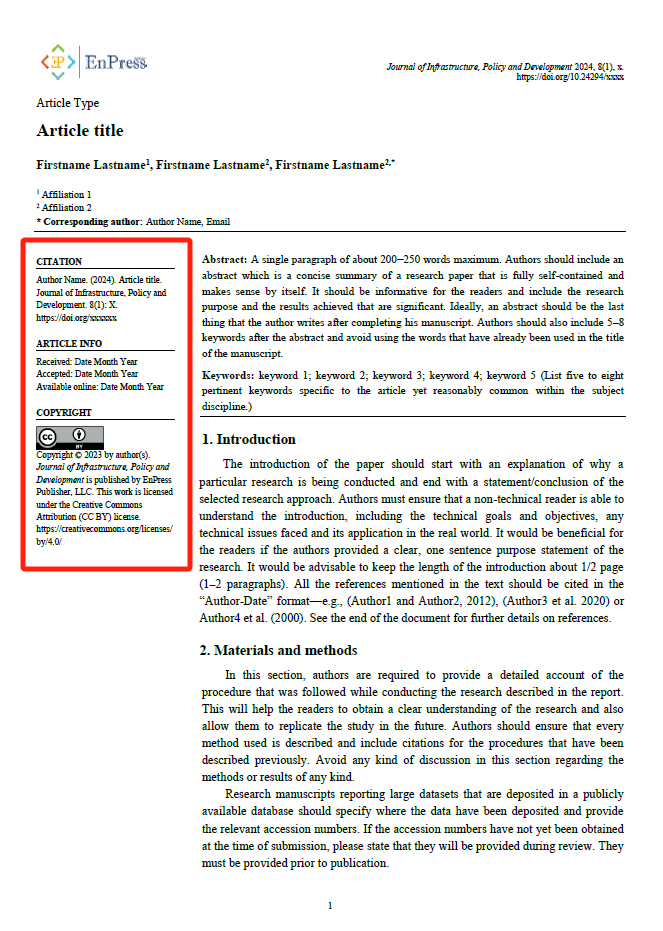2572-7923 (Print) Journal abbreviation: J. Infras. Policy. Dev. | The Journal of Infrastructure, Policy and Development (JIPD) is a multi-disciplinary, double-blind peer-reviewed journal dedicated to publishing high-quality articles on infrastructure, economic development, and public policy. The three words in the journal’s title, "infrastructure", "development" and "policy" are core to the vision of this journal. With its broad scope covering development-related issues, a novel feature of this journal is that it covers the whole range of infrastructure, including both "hard" infrastructure and "soft" infrastructure, where soft infrastructure is broadly defined to include education system, healthcare system, law enforcement, financial system, government system as well as other types of public management and institutional arrangements. JIPD has a target audience consisting of academic researchers, industry professional practitioners, and regulatory institution policymakers. It aims to provide a reliable platform for the transfer of knowledge and to facilitate discussions in the areas of development-related policy initiatives and infrastructure. Relevant (but not limited to) topics to JIPD:
|
Recently Published Issue
Vol 9, No 1 (2025)
Table of Contents
In this paper advanced Sentiment Analysis techniques were applied to evaluate public opinions reported by rail users with respect to four major European railway companies, i.e., Trenitalia and Italo in Italy, SNCF in France and Renfe in Spain. Two powerful language models were used, RoBERTa and BERT, to analyze big amount of text data collected from a social platform dedicated to customers reviews, i.e., TrustPilot. Data concerning the four European railway companies were first collected and classified into subcategories related to different aspects of the railway sector, such as train punctuality, quality of on-board services, safety, etc. Then, the RoBERTa and BERT models were developed to understand context and nuances of natural language. This study provides a useful support for railways companies to promote strategies for improving their service.
This study aims to explore the research on Chinese higher education policy from 2005 to 2024 through a bibliometric analysis. It is revealed that a continuous growth trend and sustained academic interest in this field. Mainland China leads in publication quantity, showcasing the active involvement of Chinese scholars in higher education policy research. Institutions like Peking University, the University of Hong Kong, and Beijing Normal University play significant roles in this research domain. The focus of research has shifted from student attitudes to international students, teachers, innovation models, changing demands, and urban education development, reflecting a growing emphasis on sustainability and internationalization. The study highlights the positive development trajectory of Chinese higher education policy research, with expanding research focuses and deepening concerns for sustainability and internationalization.
Modernizing the Internet of Things in Islamic boarding schools is essential to eliminate backwardness and skills gaps. Santri must have cognitive, affective, psychomotor, and creative intelligence to be ready to enter the industrial and business world. The students’ need for information transparency can be resolved using technology. This is because the empowerment of the Internet of Things has become a separate part of Islamic boarding school activities with students who can connect in real-time. This research aims to analyze current conditions and stakeholder involvement regarding the application of the Internet of Things in innovative Islamic boarding school services in the era of disruption. The Descriptive Method and Individual Interest Matrix Analysis were used by involving 130 respondents from the internal environment of the Daarul Rahman Islamic boarding school and completing the questionnaire through FGD (Focus Group Discussion) with the leaders of the Daarul Rahman Islamic boarding school. The results show that the current condition of Islamic boarding schools is that most need to learn or understand IoT, even though they are enthusiastic about learning new things and flexible in accepting change. The challenges required in implementing IoT are financial investment, increasing human resources through training, and synergy between Islamic boarding school policy makers. Mutually supportive and solid conditions are required between foundations, school principals, and school committees to implement IoT at Daarul Rahman Islamic Boarding School. Collaboration with various parties is needed because the implementation of IoT cannot be done alone by Islamic boarding schools but with the support of various related parties.
Objectives: The unprecedented COVID-19 pandemic has intensified the stress on blood banks and deprived the blood sources due to the containment measures that restrict the movement and travel limitations among blood donors. During this time, Malaysia had a significant 40% reduction in blood supply. Blood centers and hospitals faced a huge challenge balancing blood demand and collection. The health care systems need a proactive plan to withstand the uncertain situation such as the COVID-19 pandemic. This study investigates the psychosocial factors that affect blood donation behavior during a pandemic and aims to propose evidence-based strategies for a sustainable blood supply. Study design: Qualitative design using focus group discussion (FGD) was employed. Methods: Data were acquired from the two FGDs that group from transfusion medicine specialists (N = 8) and donors (N = 10). The FGD interview protocol was developed based on the UTM Research Ethics Committee’s approval. Then, the data was analyzed using Nvivo based on the General Inductive Approach (GIA). Results: Analysis of the text data found that the psychology of blood donation during the pandemic in Malaysia can be classified into four main themes: (i) reduced donation; (ii) motivation of donating blood; (iii) trends of donation; and (iv) challenges faced by the one-off, occasional, and non-donors. Conclusions: Based on the emerging themes from the FGDs, this study proposes four psycho-contextual strategies for relevant authorities to manage sustainable blood accumulation during the pandemic: (1) develop standard operating procedure for blood donors; (2) organize awareness campaigns; (3) create a centralized integrated blood donors database; and (4) provide innovative Blood Donation Facilities.
Recent times have seen significant advancements in AI and NLP technologies, poised to revolutionize logistical decision-making across industries. This study investigates integrating ChatGPT, an advanced AI language model, into strategic, tactical, and operational logistics. Examining its applicability, benefits, and limitations, the study delves into ChatGPT’s capacity for strategic logistics planning, facilitating nuanced decision-making through natural language interactions. At the tactical level, it explores ChatGPT’s role in optimizing route planning and enhancing real-time decision support. The operational aspect scrutinizes ChatGPT’s capabilities in micro-level logistics and emergency response. Ethical implications, encompassing data security and human-AI trust dynamics, are also analyzed. This report furnishes valuable insights for the logistics sector, emphasizing AI’s potential in reshaping decision-making while underscoring the necessity for foresight, evaluation, and ethical considerations in AI integration. In this publication, it is assumed that ChatGPT is not entirely reliable for decision-making in the logistics field: at the strategic level, it can be effectively used for “brainstorming” in preparing decisions, but at the tactical and operational level, the depth of the knowledge is not sufficient to make appropriate decisions. Therefore, the answers provided by ChatGPT to the defined logistic tasks are compared with real logistic solutions. The article highlights ChatGPT’s effectiveness at different levels of logistics and clarifies its potential and limitations in the logistics field.
The reduction of biodiversity and the decline in wildlife populations are urgent environmental issues with devasting consequences for ecosystems and human health. As a result, the protection of wildlife and biodiversity has emerged as one of humanity’s greatest goals, not only for protecting and maintaining human health but also for environmental, economic, and social well-being. In recent years, people have become increasingly aware of the importance and effectiveness of wildlife conservation efforts alongside environmental protection measures, sustainable agricultural practices and non-harmful production procedures and services. This study describes the development and implementation of a labeling scheme for wildlife and biodiversity protection for products or services. The label is designed to encourage the adoption of sustainable and environmentally friendly production methods and services that will contribute to biodiversity conservation and the harmonic coexistence of human-wildlife. Moreover, using a case study approach, the research presents an innovative information system designed to streamline the label-awarding process, ensuring transparency and efficiency. The established system evaluates the sustainability practices and measures implemented by businesses, with a focus on honey production in this case. Additionally, the study explores the broader social implications of the label, particularly its potential to engage consumers and promote awareness of biodiversity conservation.
Announcements
Manuscript Quality Check Process |
|
| To maintain the high standards of Infrastructure, Policy and Development, we have invited a team of academic editors who perform quality checks at every stage of the manuscript process. This ensures that every submission meets the journal's stringent requirements. For manuscripts that do not meet these standards, the team will make constructive suggestions for revisions, and publication will not occur until they meet the journal's quality standards. |
|
| Posted: 2024-11-14 | |
Publication Frequency becomes Semi-monthly |
|
| Starting from the year 2024 (Volume 8, Issue 9), the publication frequency of /JIPD/ will be changed from monthly to semi-monthly. This change will provide more frequent and timely access to cutting-edge research and insightful articles in our field. We look forward to this exciting new phase and appreciate your continued support! | |
| Posted: 2024-08-30 | |
New Style for JIPD Published Papers |
|
We have revised the layout for articles to be published in the new issues, starting at the beginning of 2024. As of today, the article templates available for download on ‘Author Guidelines’ pages have been updated. The blank column on the left runs through all pages in an article. The revised layout was applied in the article pictured below, to serve as an example:
|
|
| Posted: 2023-11-29 | |
| More Announcements... |









 ISSN:
ISSN: Open Access
Open Access

